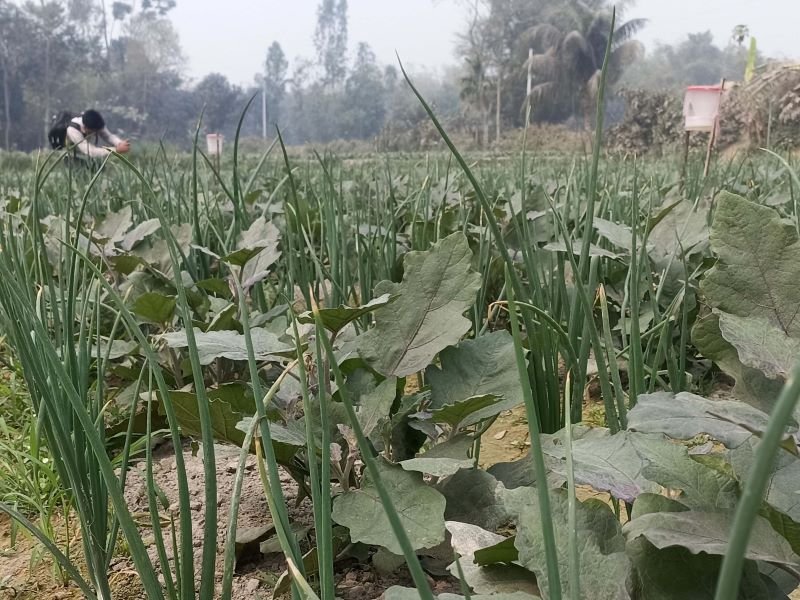We know that soil is not a lifeless entity; it is a habitat for many organisms. Soil hosts earthworms, various types of bacteria, fungi, mycorrhiza, mites, nematodes, and dung beetles, along with places for laying eggs of numerous insects and nesting spots for birds. These microorganisms, fungi, and earthworms living in the soil are integral parts of the soil ecosystem. Each of them is linked in a mutual food chain. Plants grow in soil with the collective functioning of various microorganisms and suitable weather conditions. The remains of plants and animals turn into organic matter in the soil. This cyclic process has been ongoing for eternity and will continue. Naturally, plants are flourishing, and the life cycle is completing according to natural rules. Even after billions of years, nature has not exhausted itself. We have not had to do anything for nature’s vastness, but in extracting more and more from nature, we have destroyed the natural state of the soil.
All kinds of microorganisms and animals continuously work in the soil. Through their reproductive and death cycles, these microorganisms and animals turn the organic matter bound minerals into forms that plants can absorb. As a result, soil vitality increases, and productive strength becomes dynamic. The amount of plant growth hormones and enzymes increases, soil becomes lighter, air circulation improves, water retention capacity increases, and soil acidity and alkalinity stabilize. Overall, with the increase of humus in the soil, its biodiversity is preserved.
We do not have accurate information on how many earthworms and beneficial microorganisms are reduced and die over time due to the application of chemical fertilizers and pesticides. However, it is true that the functionality of specific beneficial microorganisms has decreased due to the impact of chemicals in agriculture. That is why it has become necessary to apply essential elements from outside to the soil today. In many cases, it is seen that even with the use of harsh pesticides to control plant diseases, the severity of the disease does not decrease, and the enemy fungi are not killed.
If the application of chemical fertilizers, chemical pesticides, and herbicides is stopped, the number of beneficial microorganisms, friend fungi like Trichoderma viride, Trichoderma harzianum, Gliocladium, Aspergillus niger, Pseudomonas fluorescens, and earthworms will increase to the desired level. Thus, if the biological entity of the soil ecosystem is restored, the regular application of external microorganisms will not be necessary. Therefore, we all need to work together to bring life back to the soil and protect this soil, which is the bearer of civilization, as a sacred duty.
To restore life to the soil, we need to increase the amount of necessary organic matter besides fulfilling various deficiencies according to the soil test report. Following the methods outlined below can yield good results in applying various organic matter-rich substances as needed:
1. Using a large amount of cow dung, decomposed water hyacinth, mustard cake, neem cake, peanut cake, bone meal, and decomposed household waste significantly increases the amount of organic matter in the soil.
Method and Amount for Applying Cow Dung and Other Ingredients:
(a) If multiple crops are grown in a field in a year, 2 tons of water hyacinth and 3 tons of cow dung should be decomposed together for 45 days and then applied to each 33 decimals (about one-third of an acre) of land twice a year. It is better not to use hybrid cow dung to increase soil fertility. However, if necessary, 6 tons of hybrid cow dung and 3 tons of water hyacinth should be decomposed together for at least 90 days and then applied to each 33 decimals (about one-third of an acre) of land.
(b) Decomposing various seed cakes for 14-21 days and applying 30-50 kg per 33 decimals yields good results.
(c) Bone meal should be used once a year at 30-50 kg 33 decimals of land.
(d) There is no harm in using as much household waste as possible.
2. Using various types of compost such as quick compost, vermi compost, pit compost, cage compost, and Tricho compost can increase organic matter in the soil. These composts should be applied at 8-10 kg per decimal of land during the base application and 3 kg per decimal of land during subsequent applications.
– Note: Quick compost and Tricho compost have limitations. Using them excessively can harm plants.
3. Growing crops like beans, lentils, mung beans, peas, chickpeas, peanuts, soybeans (non-GMO), jute, pigeon peas, and Sesbania can add a lot of organic matter to the soil along with yielding crops.
4. Cultivating plants like Gliricidia, mulberry, jute, and indigo provides a significant amount of nitrogen and organic matter.
5. Leaving some parts of the crops in the field during harvesting instead of uprooting them can turn them into organic matter as they decompose in the soil.
6. Growing plants like Sesbania, jute, and ferns and mixing them with soil at the age of 45-60 days can increase organic matter as green manure rich in nitrogen. Growing legumes can add 30-60 kg of nitrogen per acre.
7. Mixing crop residues like leaves and stems with the soil can increase organic matter.
8. Growing blue-green algae and Azolla can also increase organic matter.
9. Using liquid or microbial fertilizers can increase organic matter.
10. Composting non-crop plants and leftover companion crops after weeding and applying them to the field can significantly increase the amount of organic matter.
In addition to the above methods, nitrogen is added to the soil in various ways, such as naturally through lightning, which binds 10 million tons of nitrogen annually to the soil, and biological nitrogen fixation, which amounts to 175 million tons. Seasonal rainfall also adds nitrogen to the soil, approximately 10 kg per acre. Blue-green algae, a type of fern, and Azolla growing in rice fields and aquatic areas can add nitrogen to the soil, which can individually add 8-10 kg of nitrogen on average. These Azolla can also control nematodes.
More posts:
No related posts.
